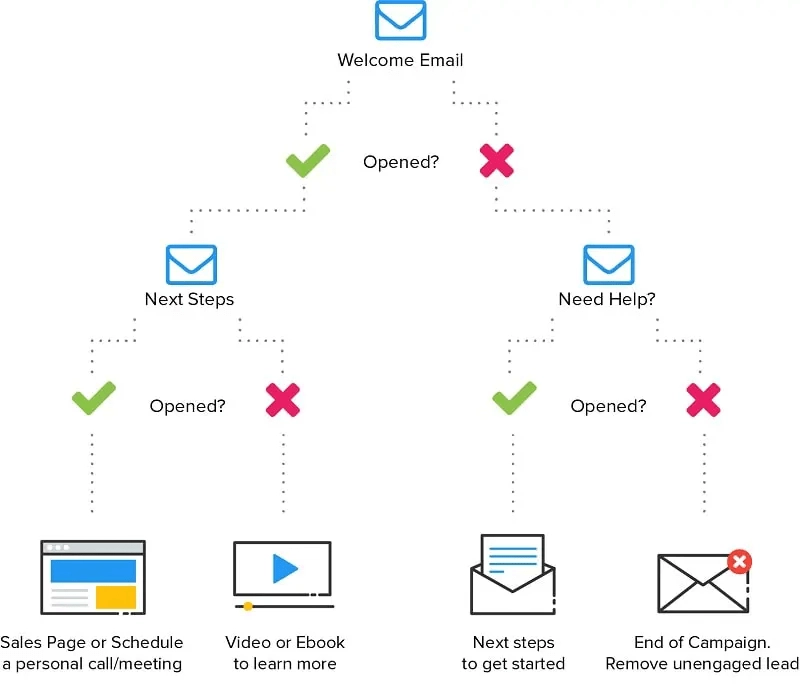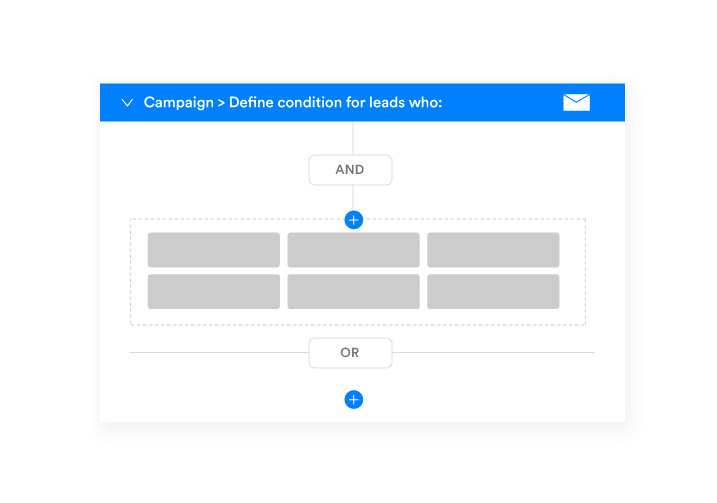[ad_1]
What’s the best way to add personalization to your email marketing strategy?
Using automated email workflows.
Email workflows run in the background – sending the right messages to the right people at the right time. Once you set these up, you can focus on other business areas – knowing that your email marketing is doing everything it can.
Let’s explore how automated email workflows work and exactly what types of email workflows you can apply to your business. In this article:
- What are Automated Email Workflows?
- Why Automated Email Workflows are so beneficial?
- 10 Examples of Automated Email Workflows Your Business Can Send
- How to Implement Automated Email Workflows into Your Business
What are Automated Email Workflows?
Automated email workflows are a planned series of emails that are sent automatically to people based on certain triggers or actions. They are designed to keep leads or customers interested in your business and help them along their journey with your brand.
Email workflows send the right information to the right person at the right time, such as welcome emails, follow-ups, reminders, or promotions. You can also use email workflows to manage your email subscribers and automatically segment them into different lists.
By automating this process, businesses save time and make sure they always communicate consistently. This makes their email marketing more efficient and effective.
Why Automated Email Workflows are so Beneficial
Any business can use automated email workflows to improve the customer journey and enhance their email marketing efforts. Here are some of the main reasons why.
Save Time and Effort
Email workflows save time and effort by automating repetitive tasks, such as sending welcome emails or follow-ups. This frees up resources for other important business activities.
As a small business owner, automation can help you achieve much more without all the resources of a large marketing and sales team.
It’s a Great Way to Nurture Leads
Using automated email workflows is highly beneficial for nurturing leads in the sales funnel.
Email workflows allow businesses to deliver timely and relevant information to leads, guiding them through the buying process.
By setting up a series of automated emails, you can provide educational content, product information, case studies, or testimonials that address the leads’ specific needs and pain points. This helps build trust, establish credibility, and keep your brand top-of-mind.
Improve Customer Engagement
Email workflows ensure consistent communication by sending targeted messages at the right time. This improves customer engagement, as people will be more interested in what your email content is about.
Turn More Leads Into Customers
Email workflows help nurture leads and customers by delivering relevant content based on their behavior or preferences. Because this content is more targeted to your lead’s interests and behaviors, it has a far greater chance of turning leads into customers.
Improve Decision-Making
Using automated email workflows helps businesses track and analyze their email performance. With access to the right email marketing metrics, businesses can make more data-driven decisions.
10 Examples of Automated Email Workflows Your Business Can Send

Now that you know what email workflows are, the next step is understanding how to apply them to your business.
Here are ten examples of ways you can use email workflows to generate more customers.
Leads Who Didn’t Convert Due to Pricing Concerns
Implement a two-email sequence offering an exclusive discount or limited-time promotion to incentivize them to make a purchase.
The first email can highlight the value and benefits of your products or services, addressing any objections they may have had. The second email can emphasize the limited nature of the offer, creating a sense of urgency and prompting them to take action.
Abandoned Cart Recovery
Create a three-email sequence targeting customers who added items to their cart but didn’t complete the purchase.
The first email can serve as a reminder, displaying the abandoned items and offering assistance or answers to any questions they may have. The second email can include customer testimonials or reviews, reinforcing the value and quality of your products. The final email could provide a limited-time discount or free shipping offer to encourage them to return and complete their purchase.
New Customer Welcome Series
Send a three-email sequence to new customers, introducing them to your business and building a relationship.
The first email can thank them for their purchase and provide order details. The second email can provide useful tips or tutorials related to their purchase, showcasing the value of your products or services. The final email can offer an exclusive discount on their next purchase, encouraging them to become repeat customers.
Inactive Customer Re-Engagement
Develop a two-email sequence targeting customers who haven’t made a purchase or engaged with your business in a specified period.
The first email can express concern for their inactivity and offer a special incentive or personalized recommendation based on their previous interactions. The second email can highlight any updates, new products, or exclusive offers to reignite their interest and prompt them to take action.
Upsell/Cross-Sell Campaigns
Create a series of emails aimed at existing customers to promote complementary products or higher-tier options.
The first email can introduce the new product or upgrade, emphasizing its benefits and how it enhances their current purchase. The subsequent emails can showcase customer success stories, highlight exclusive features, and offer limited-time discounts to incentivize upsells or cross-sells.
Birthday/Anniversary Emails
Send personalized emails to customers on their birthday or anniversary with your business. The email can include a special discount, free gift, or exclusive offer as a token of appreciation.
This gesture not only strengthens customer loyalty but also encourages repeat purchases and referrals.
Post-Purchase Follow-Up
Implement a two-email sequence to check in with customers after purchasing, ensuring satisfaction and encouraging reviews or referrals. The first email can express gratitude for their purchase, provide any necessary post-purchase instructions, and invite them to share their feedback. The second email, sent a few weeks later, can request a review on relevant platforms and offer an incentive for referrals, rewarding customers for spreading the word about your business.
Educational/Informative Series
Develop a series of emails that provide valuable content and insights related to your industry or niche.
Each email can focus on a specific topic, offering tips, best practices, or case studies. By positioning your business as an authority and providing relevant information, you can establish trust with your audience and increase engagement.
Event Invitation
Send a series of emails to promote an upcoming event or webinar.
The first email can briefly introduce the event, highlighting its benefits and key details. The subsequent emails can feature guest speakers, highlight agenda updates, and offer exclusive perks or early bird discounts to drive registrations.
Feedback and Testimonial Requests
Implement a two-email sequence to gather feedback from customers and request testimonials.
The first email can ask for their feedback on their experience with your business, including any suggestions for improvement. The second email can thank them for their feedback and kindly request a testimonial or review on relevant platforms. You can offer a small incentive, such as a discount or exclusive content, as a token of appreciation for their time and input.
How to Implement Automated Email Workflows into Your Business
Implementing automated email workflows into your business can be a valuable strategy to streamline communication, nurture leads, and drive conversions.

Here’s a step-by-step guide on how to implement automated email workflows effectively.
- Define Your Goals
Identify the specific objectives you want to achieve through your email workflows. Whether it’s increasing sales, nurturing leads, retaining customers, or promoting specific products/services, clear goals will help shape your workflow strategy.
- Segment Your Audience
Divide your customer base into distinct segments based on criteria like demographics, purchase history, engagement level, or interests. This segmentation allows you to tailor your email workflows to specific groups, ensuring relevance and personalization.
- Choose the Right Email Marketing Software
Select a reliable email marketing platform that provides automation capabilities. Consider factors such as ease of use, integration options, reporting features, and scalability to find the best fit for your business.
- Map Out Your Workflows
Visualize the customer journey and outline the sequence of emails you want to send for each segment. Determine the triggers that will initiate each workflow, such as sign-ups, purchases, or specific actions taken on your website.
- Create Compelling Content
Craft engaging and relevant content for each email in your workflows. This can include personalized greetings, informative resources, exclusive offers, compelling calls-to-action, and visually appealing designs. Ensure that your content aligns with the purpose and stage of each workflow.
- Set Up Automation Rules
Configure the automation rules within your email marketing platform to trigger the workflows based on specific conditions or actions. These rules could be based on time intervals, specific dates, or customer behavior.
- Test and Optimize
Before launching your workflows, conduct thorough testing to ensure the emails render correctly, the links work, and the automation rules are functioning as intended. Monitor the performance of your workflows and use analytics to identify areas for improvement.
- Monitor and Measure Results
Regularly track and analyze the performance of your email workflows. Monitor metrics such as open rates, click-through rates, conversion rates, and revenue generated. Use this data to refine your workflows and optimize their effectiveness.
- Iterate and Improve
Continuously refine and enhance your email workflows based on the insights gathered. Experiment with different subject lines, content variations, and timing to find the most impactful strategies for your audience.
- Maintain Engagement and Relevance
Regularly update and refresh your email workflows to keep them current and engaging. Stay attuned to customer preferences and adapt your content and strategies accordingly.
Ready to Automate Your Email Marketing?
With the right approach, anyone can implement email workflows into their business to help them save time and improve email marketing results. With a platform like Propel IQ, this is incredibly easy to do.
The automated email marketing software is all part of the same platform as your leads database, lead generation tools, and a whole lot more This means anyone can build a website, set up automated email workflows, and watch as they deliver awesome results.
Interested in getting started? Get in touch to see how we can help you create automated email workflows that grow your business.
![]() tom
tom
[ad_2]
Source link


